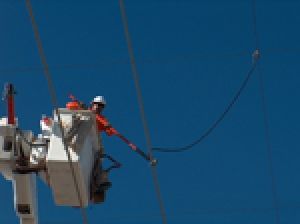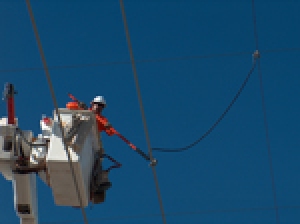
Strategic Safety Partners

In 2004, the Occupational Safety and Health Administration (OSHA) entered into the Electrical Transmission & Distribution (ET&D) Strategic Partnership agreement with six electrical contractors: Asplundh Tree Expert Co., Henkels & McCoy, MDU Construction Services Group, MYR Group, Pike Electric and Quanta Services; one union: the International Brotherhood of Electrical Workers (IBEW); and two trade associations: the National Electrical Contractors Association (NECA) and Edison Electric Institute (EEI). The primary objective of this partnership is to improve worker safety in the high-voltage electric line construction industry. Members of the partnership have renewed their agreements with OSHA and expanded in 2006, 2008, 2010 and, most recently, in 2011 with the addition of MasTec and Power Line Services to the list of membership partners. Today the ET&D Strategic Partnership is one of only a few national partnerships between employers and the federal job safety agency, and covers an estimated 80 percent of total workers in the line construction industry.
Changing Safety Culture
The ET&D Strategic Partnership focuses on improving worker safety culture through long-term effective strategies that are dynamic and reactive to identified problem areas and proactive wherever possible. The four main goals of the partnership include thorough data analysis to establish causes of fatalities, injuries and illnesses; development and implementation of best practices; development and delivery of specific training courses; and establishment of effective communication to promote the importance and value of occupational safety and health.
The partnership continues to strive to promote safe work practices by staying involved in many different safety and health outreach and promotion activities specifically targeting the power transmission and distribution industry, including the development of best practices and training programs and videos, posting information at www.powerlinesafety.org, presenting at major safety conferences and conducting safety stand downs.
Specific partnership accomplishments include the implementation of an OSHA-approved ET&D 10-hour training program for electrical power employees and the ET&D 20-hour supervisory leadership program. The 20-hour program emphasizes supervisor and management knowledge and skills development as well as the importance of management support as it relates to implementation.
Training and Performance Results
The ET&D Strategic Partnership is achieving common goals by analyzing accident and injury data for causal factors, providing quality training and implementing best practices. Partnership participants have succeeded in reducing the number of fatal accidents they experience. While the goal is always zero injuries and zero fatalities, this reduced statistic clearly indicates the importance and success of this partnership effort.
Injury and illness rates in the utility construction industry as a whole are trending downward. Each year the partnership has succeeded in achieving both total case incident rates (TCIR) and days away, restrictions and transfers (DART) rates that are below the industry national average. Overall, the partnership’s participating employers have maintained injury and illness rates below that of the industry.
Strategic Partnership Best Practices
The ET&D Strategic Partnership has developed and collectively approved several effective best practices – listed below – to create a safe work environment and build a safety culture within the line construction industry.
Best Practice: Job briefing
Practice Statement: Provides a uniform methodology and outlines key components of a job.
Benefits:
• Provides for essential job safety planning guidelines and lists key elements.
• Enhances compliance with OSHA regulatory requirements.
• Incorporates use of a specific hazard identification process in the job planning process that will provide for enhanced risk controls.
• Proper preplanning reduces the risk of injury.
• The process and required documentation enhance inclusion and participation of team members in the safety planning processes associated with the job.
Best Practice: Pre-use inspection of rubber protective equipment
Practice Statement: Protocols related to the effective inspection of insulated protective equipment.
Benefit:
• Provides for uniform inspection guidelines that can be applied industry-wide.
Best Practice: Administrative controls
Practice Statement: Eliminate injuries to personnel from improper job planning and risk assessment.
Benefit:
• Eliminate injuries resulting from improper planning by ensuring key job hazards are identified and controlled, and provide support to contractors in obtaining needed information for effective risk assessments.
Best Practice: Qualified observer
Practice Statement: Identify and utilize qualified observer for critical tasks.
Benefits:
• Eliminates injuries from unrecognized hazards or changes in conditions.
• Clarifies duties and provides guidance as to when observers are beneficial.
• Provides guidance on observer qualifications.
Best Practice: Insulate and isolate safety performance check
Practice Statement: Review of qualifications and/or performance criteria to ensure compliance with isolate and insulate procedures.
Benefits:
• Routine auditing provides for performance and regulatory assurance for critical control techniques.
• Effective auditing will enable enhanced and consistent performance.
Best Practice: Lock-to-lock use of insulating rubber gloves and sleeves
Practice Statement: Protocols related to effective use of insulating rubber gloves and sleeves.
Best Practice: Cradle-to-cradle use of insulating rubber gloves and sleeves
Practice Statement: Protocols related to effective use of insulating rubber gloves and sleeves.
Best Practice: Rubber insulating PPE for the live-line tool method on distribution lines
Practice Statement: Use of rubber insulating gloves and sleeves while performing distribution power line tasks via the live-line tool method.
Benefits for lock-to-lock, cradle-to-cradle and rubber insulating PPE:
• Provide specific use requirements that are proven methods for reducing electrical contact injuries and fatalities.
• Provide for uniform use guidelines that can be applied industry-wide.
Best Practice: Safety at heights – fall protection on wood poles
Practice Statement: Fall protection equipment (FPE) shall be used when ascending, descending, changing position and when in the working position while on a wood pole.
Benefit:
• To eliminate injuries and fatalities associated with falls from wood poles.
Best Practice: Safety at heights – fall protection on lattice structures
Practice Statement: FPE shall be used when ascending, while in the working position, when changing positions, and when descending and/or performing rescue operations while on a lattice structure.
Benefit:
• To eliminate injuries and fatalities associated with falls from lattice structures.
For more information on all best practices, visit www.powerlinesafety.org.
Editor’s Note: This article was submitted by Task Team IV from the Electrical Transmission & Distribution Strategic Partnership.

